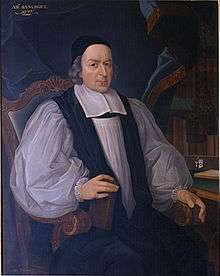William Sancroft
| The Most Reverend and Right Honourable William Sancroft | |
|---|---|
| Archbishop of Canterbury | |
 William Sancroft | |
| Installed | 1677 |
| Term ended | 1690 |
| Predecessor | Gilbert Sheldon |
| Successor | John Tillotson |
| Personal details | |
| Born |
30 January 1617 Ufford Hall, Fressingfield, Suffolk, England |
| Died |
24 November 1693 (aged 76) Ufford Hall, Fressingfield, Suffolk, England |
| Buried | Church of St. Peter and St. Paul, Fressingfield |
| Alma mater | Emmanuel College, Cambridge |
William Sancroft (30 January 1617 – 24 November 1693) was the 79th Archbishop of Canterbury, and was one of the Seven Bishops imprisoned in 1688 for seditious libel against King James II, over his opposition to the king's Declaration of Indulgence.
Life
Sancroft was born at Ufford Hall in Fressingfield, Suffolk, son of Francis Sandcroft (1580–1647) and Margaret Sandcroft née Butcher (1594–1631). He was educated at the Bury St Edmunds free grammar school before being admitted to Emmanuel College, Cambridge, in September 1633 and matriculating there in 1634.[1] He became M.A. in 1641 and fellow in 1642, but was ejected in 1649 for refusing to accept the "Engagement." He then remained abroad till the Restoration, after which he was chosen one of the university preachers, and in 1663 was nominated to the deanery of York. He became Dean of St Paul's in 1664, greatly assisting with the rebuilding after the Great Fire of London,[2] towards which he contributed £1400. He also rebuilt the deanery, and improved its revenue.
In 1668 he was admitted Archdeacon of Canterbury upon the king's presentation, but he resigned the post in 1670. In 1677, being now prolocutor of the Convocation, he was unexpectedly advanced to the archbishopric of Canterbury, at the express wish of the King who trusted in his moderation. So unwilling was he to accept that the King only persuaded him by explaining that he had already appointed the new Dean of St Paul's. He attended Charles II upon his deathbed, and "made to him a very weighty exhortation, in which he used a good degree of freedom." He crowned King James II in 1685.[2] Sancroft wrote with his own hand the petition presented in 1688 against the reading of the Declaration of Indulgence, which was signed by himself and six of his suffragans (collectively known as the Seven Bishops). For this they (of whom Sancroft was oldest, at 71) were all committed to the Tower of London, but were acquitted.
Nonjuring schism
Upon the withdrawal of James II he concurred with the Lords in a declaration to William III for a free parliament, and due indulgence to the Protestant dissenters. But, when William and his wife (James's daughter) Mary were declared king and queen, he refused to take the oath to them, and was accordingly suspended and deprived in 1690.[3] In August 1690 John Tillotson took over his duties. In April 1691 Tillotson officially became Sancroft's successor.
Many years after it was composed, John Overall's Convocation Book was published by Sancroft, to justify the principles of his Nonjuring party. The book was “on the subject of Government, the divine institution of which was very positively asserted.” It consisted partly of canons and partly of introductory and explanatory dissertations on the matter of the canons and had been duly sanctioned in the Convocation of 1610. It was, however, a strange oversight in Sancroft's party to publish the book, as there are several canons in it which clearly lay down that a de facto government is, when completely established, to be held in the light of a de jure government; and it was upon the very grounds set forth in this book that Sherlock took the oaths to King William.[4]
Sancroft was a patron of Henry Wharton (1664–1695), the divine and church historian, to whom on his deathbed he entrusted his manuscripts and the remains of Archbishop Laud (published in 1695). From 5 August 1691 until his death two years later, he lived a very retired life in his native village of Fressingfield. He died at his family home, Ufford Hall, and was buried in the churchyard of Fressingfield, where there is a Latin epitaph to his memory.[2]
See also
Bibliography
- Fur praedestinatus (1651)
- Modern Policies (1652)
- Three Sermons (1694)
- Nineteen Familiar Letters to Mr North (afterwards Sir Henry North) published in 1757
- The Life of William Sancroft, Archbishop of Canterbury, Volume I by George D'Oyly (1821)
- The Life of William Sancroft, Archbishop of Canterbury, Volume II by George D'Oyly (1821)
References
- ↑ "Sancroft, William (SNDT633W)". A Cambridge Alumni Database. University of Cambridge.
- 1 2 3 "William Sancroft". Retrieved 5 July 2007.
- ↑ "William Sancroft". Retrieved 5 July 2007.
- ↑ King’s Handbook to the Cathedrals of England, by Richard John King, published by John Murray, Albemarle Street, Oxford, 1862, p166.
![]() This article incorporates text from a publication now in the public domain: Chisholm, Hugh, ed. (1911). "article name needed". Encyclopædia Britannica (11th ed.). Cambridge University Press.
This article incorporates text from a publication now in the public domain: Chisholm, Hugh, ed. (1911). "article name needed". Encyclopædia Britannica (11th ed.). Cambridge University Press.
| Church of England titles | ||
|---|---|---|
| Preceded by Gilbert Sheldon |
Archbishop of Canterbury 1678–1691 |
Succeeded by John Tillotson |